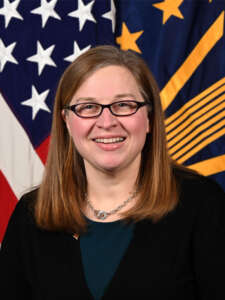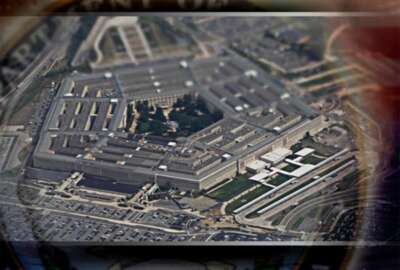Growth of OTAs, corresponding myths gave DoD plenty of reason to update its guide
MaryKathryn Robinson, the director for contract policy in the Office of Defense Pricing and Contracting, said in 2022 92% of the OTAs were awarded to those OTA ...
Part of that sigh of relief that you may have heard coming from the Pentagon when Congress passed the 2024 defense authorization bill was for no major new requirements for managing other transaction agreements (OTA) authority.
The two provisions in the NDAA around OTAs were minimal, including asking the Government Accountability Office to report on the Defense Department’s spending through this process.
The fact Congress left OTAs mostly alone is a good thing as DoD recently updated its guidance for using this tool.
MaryKathryn Robinson, the director for contract policy in the Office of Defense Pricing and Contracting, said the growth of OTAs over the last seven years truly precipitated the new how-to guide.

“We want to be able to help the DoD acquisition community as well as our partners in industry, academia and nonprofits to help define what an OTA is, and help them create the best OTAs that they can,” Robinson said in an interview with Federal News Network. “We made those updates based on changes in statute and regulation, and recommendations that we received from the DoD inspector general and from the Government Accountability Office. But then we also added administrative guidance and best practices for things like reporting funding, participation and validation of those non-traditional defense contractors, protest procedures, agreements, contract officer warranting and training, and then other considerations for folks to take into account as they move forward with their OTAs.”
DoD hadn’t updated its OTA guide in about five years and a lot has changed since then both in the use of these approaches as well as concerns about them.
Between 2016 and 2022, Robinson said DoD has taken about 15,000 OTA actions, which includes both new agreements and modifications. Those 15,000 actions were worth about $70 billion.
The real push for OTAs, however, came after 2018. In 2016, for example DoD took about 333 OTA actions worth $1.3 billion. By 2020, and that includes the use of OTAs as part of the response to COVID-19, DoD took 3,200 OTA actions worth $16 billion.
“We’ve come down a little bit in our dollar spend. But right now in 2022, our last year of full data, we had about 4,400 actions for about $10.7 billion. Right now we’re thinking that, and I don’t have the final 2023 numbers, but I think that 2023 is going to come in around that,” Robinson said. “I know that about 80% is for research and development. Then, we have a couple OTAs for weapons and ammunition, electronic and communication equipment or professional services.”
While 2023 data isn’t finalized, HigherGov, a government market intelligence company, estimated that in 2023, DoD had more than 1,200 active OTAs worth more than $23.6 billion.
During those growth years, Congress has paid close attention to DoD’s use of OTAs. In the 2020 NDAA, for example, Congress required a report from the Pentagon on the use of OTAs for prototype projects.
In the 2024 NDAA, Congress told GAO to submit a report by Feb. 1, 2025 on the use of OTAs with a focus on:
- The extent to which such transactions are used in accordance with policy and guidance related to the use of such transactions;
- The total number of transactions for each fiscal year made to nontraditional defense contractors;
- A summary of such transactions to which DoD is a participant for which performance has not been completed on the date of submission of such report, including— (a) a description of the entity or agency responsible for any consortium; (b) the number of members in each consortium, including the percentage of such members who are nontraditional defense contractors for each such consortium; (c) the total amount awarded under such transactions to each consortium manager for fiscal years 2022 and 2023; (d) the total amount awarded under such transactions to members who are nontraditional defense contractors for each such consortium for fiscal years 2022 and 2023; and (e) a list of contractors who have been awarded more than $20.0 million under such transactions, including a brief description of each such award, the number of awards made, and the total dollar amount awarded for fiscal years 2022 and 2023.
The second OTA related provision in the 2024 NDAA focused on clarifying the use of OTAs for installation or facility prototyping. Congress also increased the amount of the agreement to $300 million from $200 million.
Non-traditional vs. traditional contractors
Despite the growth, concerns and myths about how DoD is using OTAs continue to survive.
Robinson said one key feature of the guide is to dispel many of those myths.
One big one is “traditional” defense contractors get many of these awards. Robinson said while it may look like the big defense contractors are winning many of the OTA agreements, DoD measures participation by non-traditionals differently than just by who signed the agreement.
“The requirement is for a non-traditional defense contractor to be part of the team in a significant way. In fiscal 2022, 92% of our OTAs were awarded to those OTA contractors or performers that had a non-traditional defense contractor performer on they’re doing something and in a significant way,” she said. “What does it mean to say ‘in a significant way?’ The agreements officers are actually held to figure that out and make that determination and make that independent judgment. Significant is not necessarily dollars. Significant could be specifically a key technology or a specific cost reduction. Some of the things that we look at is does the non-traditional defense contractor supply a new key technology, product or process? Do they have a novel application or approach to technology? Do they have material increase in the performance efficiency of a key technology? Do they result in a material reduction in cost and schedule a project or to provide a material increase in the performance of the prototype project? So again, that does not necessarily mean that they’re the prime contractor on something. But it does mean that they’re doing some heavy lifting on the actual project itself.”
Another big myth DoD tries to dispel is that OTAs aren’t, or don’t need to be, competitive.
Robinson said DoD not only encourages competition for OTAs, but actually benefits the military service or defense organization in the long run.
“The other benefit of a competitive prototype OTA is that you can go to a non-competitive follow on production award out of that,” she said. “Another myth that we continually hear is that OTAs can only be awarded through consortium. In 2022, 50% of our OTA actions were awarded through or to a consortium. But again, it’s only 50%. OTAs can be awarded to a single company. They can be awarded to a joint venture. They can be awarded through partnerships.”
In addition to mythbusting, DoD included uses cases, a step-by-step approach to executing OTAs, legal considerations and definitions of the different types of agreements.
Robinson said there is a lot of training and other tools to help DoD use OTAs.
“OTAs are an opportunity for agreements officers to be flexible and to be innovative and to work with their partners in industry, academia, to come up with something terrific, novel and inventive for the warfighter,” she said. “Hopefully they recognize the guide is not here to prescribe any approaches, but it’s here to help them figure out how to use that OTAs appropriately so we can meet the warfighter needs.”
Copyright © 2024 Federal News Network. All rights reserved. This website is not intended for users located within the European Economic Area.
Jason Miller is executive editor of Federal News Network and directs news coverage on the people, policy and programs of the federal government.
Follow @jmillerWFED






